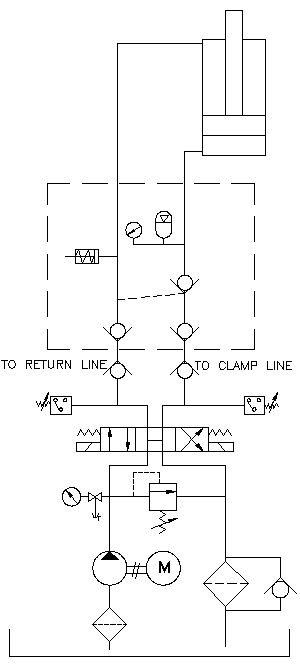PART NO. 4500137 :

Hydraulic Circuit Coupling Unit :

Description :
Hydraulic coupling units are used whenever the fixture is separated from the pressure generator, e.g. in flexible manufacturing systems. This fully equipped coupling unit has been developed for manual coupling and uncoupling for the purpose of clamping and unclamping. This unit includes two quick disconnect coupling (QDC) to connect / disconnect 'Hydraulic Power Unit', Pilot operated check valve to hold pressure in clamping line, Accumulator to compensate leakage (if any) in clamp line, Glycerin filled pressure gauge , Built in single acting cylinder takes care of across piston leakage and avoid building pressure in return line.
Versions :
- For double acting elements - Part No. 4500137
- For single acting elements - Part No. 4500155
Installation :
This unit is mounted on pallet which is moving and live hydraulics is not continously available
Specifications of coupling unit:
- Minimum operating Pressure: 50 bar
- Maximum operating Pressure: 250 bar
- Accumulator charging Pressure: 80 %of Operating pressure
- Accumulator Volume: 75 cc
- Total volume of the cylinder: 500 cc
Specifications of power unit:
- Hydraulic power unit with control panel
- Pump output: 1.8 lpm.
- Motor: 3 phase, 1 hp.
- Tank Capacity: 30 liters approximately.
- Useful oil volume - 25 liters approximately.
Power Unit Hydraulic Circuit
This unit should have direction control valve, which is double solenoid, spring centered, and center open. At center position pressure line is connected to tank line and motor is unloaded. Due to this one can connect / disconnect quick disconnect coupling at center position. Push buttons are provided on pendent for ease of operation.
Sequence of operation
A) Clamping
- QDC is connected if it is not in coupled position.
- Push the clamp button, pressure will build and Ready for Disconnection lamp (green) will glow.
- Disconnect QDC and put dust caps.
- Now job is in clamped condition and pallet is ready to move.
B) Unclamping
- Remove dust cap and clean quick disconnect coupling.
- In un-pressurized mode connect QDC. (Ready for Connection / Disconnection lamp is on)
- Push unclamp button, all elements will retract and gauge show zero pressure. And ready for Disconnection lamp will glow.
- Now job can be removed and new job can be placed.

